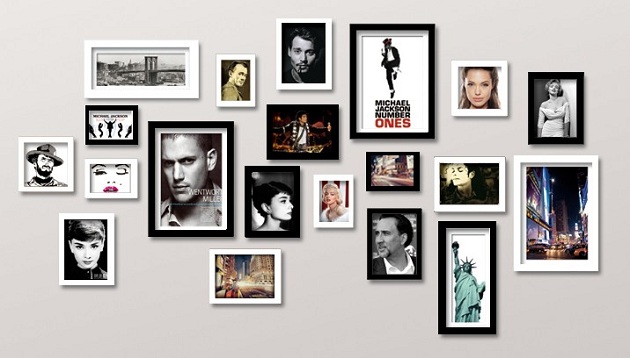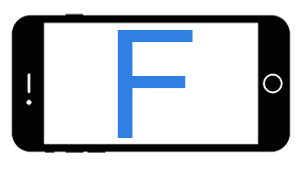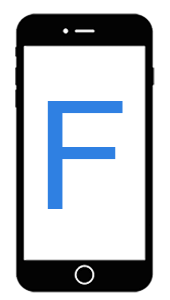iOS自定义拍照框拍照&裁剪(一)
-
卡片机时代
很重要的一点是,相机本身是没有方向概念的,它不理解拍摄的内容,只会以相机自己的坐标系去保存数据,下图展示了相机对“F”进行四个角度拍摄时返回的图片数据。


最初的卡片机时代,照片都会经由底片洗出来,那时不存在照片的方向问题,我们总可以把洗出来的照片通过简单的旋转来进行观看。比如这张照片墙中的照片,你能否说哪些照片是横着?哪些颠倒着?你甚至都无法判断每张照片相机是以何种角度拍摄的,因为每张都已经旋转至适合观看的角度。

-
数码时代
可是到了数码时代,不再需要底片,照片需要被存成一个图像文件。对于上面的拍摄角度,存储方式并没有变化,所有的场景仍然是以相机的坐标系来保存。于是这些照片仍像上面一样,原封不动的保存了下来。
虽然存储方式不变,和卡机机时代的实体相片不同的是,由于电子设备可不知道照片应该如何旋转,只能够以它存储于磁盘中的方向来展示。这便是为何照片传到电脑上之后,会出现横了,或者颠倒的情况。
-
方向传感器
为了克服这一情况,让照片可以真实的反应人们拍摄时看到的场景,现在很多相机中就加入了方向传感器,它能够记录下拍摄时相机的方向,并将这一信息保存在照片中。照片的存储方式还是没有任何改变,它仍然是以相机的坐标系来保存,只是当相机来浏览这些照片时,相机可以根据照片中的方向信息,结合此时相机的方向,对照片进行旋转,从而转到适合人们观看的角度。
-
iPhone上的情况
在iOS的设备中也包含了方向传感器,它但是它默认的照片方向并不是竖着拿手机时的情况,而是横向,即Home键在右侧,如下:

如此一来,如果竖着拿手机拍摄时,就相当于对手机顺时针旋转了90度,也即上面相机图片中的最后一幅

-
iPhone拍照方向问题处理
iPhone通过API获取到的是图片内容数据,不带方向信息,此时,我们需要手动的根据传感器方向将方向信息填充进去,并且根据方向信息对照片进行相应的旋转,得到人类视角正向的图片。代码如下:
//iOS11以上支持AVCapturePhotoOutput代理
- (void)captureOutput:(AVCapturePhotoOutput *)output didFinishProcessingPhoto:(AVCapturePhoto *)photo
error:(NSError *)error {
if (error) {
NSLog(@"获取图片错误 --- %@",error.localizedDescription);
}
if (photo) {
UIImageOrientation orient = UIImageOrientationUp;
//后置摄像头
if (self.shootingOrientation == UIDeviceOrientationLandscapeRight){
orient = UIImageOrientationDown;
}else if(self.shootingOrientation == UIDeviceOrientationPortrait){
orient = UIImageOrientationRight;
}else if(self.shootingOrientation == UIDeviceOrientationLandscapeLeft){
orient = UIImageOrientationUp;
}else if(self.shootingOrientation == UIDeviceOrientationPortraitUpsideDown){
orient = UIImageOrientationLeft;
}
//前置摄像头
AVCaptureDevice *currentDevice = [self.videoWriterManager.videoInput device];
AVCaptureDevicePosition currentPosition = [currentDevice position];
if (currentPosition == AVCaptureDevicePositionFront){
//前置摄像头
if (self.shootingOrientation == UIDeviceOrientationLandscapeRight){
orient = UIImageOrientationUp;
}else if(self.shootingOrientation == UIDeviceOrientationLandscapeLeft){
orient = UIImageOrientationDown;
}
}
UIImage *image = [UIImage imageWithCGImage:photo.CGImageRepresentation scale:1 orientation:orient];
//图片修正为人类视角看起来正向的图片
//[self fixOrientation:image];
}
}
//将原始图片数据调整为 人类视角正向的图片
- (UIImage *)fixOrientation:(UIImage *)image{
// No-op if the orientation is already correct
if (image.imageOrientation == UIImageOrientationUp) return image;
// We need to calculate the proper transformation to make the image upright.
// We do it in 2 steps: Rotate if Left/Right/Down, and then flip if Mirrored.
CGAffineTransform transform = CGAffineTransformIdentity;
CGFloat imageWidth = CGImageGetWidth(image.CGImage);
CGFloat imageHeight = CGImageGetHeight(image.CGImage);
//创建的位图宽高
CGFloat contextWidth = imageWidth < imageHeight ? imageWidth : imageHeight;
CGFloat contextHeight = imageWidth > imageHeight ? imageWidth : imageHeight;
switch (image.imageOrientation) {
case UIImageOrientationDown:
case UIImageOrientationDownMirrored:{
//创建横着显示的位图上下文,宽大于高
CGFloat temp = contextWidth;
contextWidth = contextHeight;
contextHeight = temp;
//旋转180度
transform = CGAffineTransformTranslate(transform, contextWidth, contextHeight);
transform = CGAffineTransformRotate(transform, M_PI);
}
break;
case UIImageOrientationLeft:
case UIImageOrientationLeftMirrored:
//逆时针旋转90度
transform = CGAffineTransformTranslate(transform, contextWidth, 0);
transform = CGAffineTransformRotate(transform, M_PI_2);
break;
case UIImageOrientationRight:
case UIImageOrientationRightMirrored:
//顺时针90度
transform = CGAffineTransformTranslate(transform, 0, contextHeight);
transform = CGAffineTransformRotate(transform, -M_PI_2);
break;
default:
break;
}
switch (image.imageOrientation) {
case UIImageOrientationUpMirrored:
case UIImageOrientationDownMirrored:
//镜像图片Y轴翻转坐标系
transform = CGAffineTransformTranslate(transform, contextWidth, 0);
transform = CGAffineTransformScale(transform, -1, 1);
break;
case UIImageOrientationLeftMirrored:
case UIImageOrientationRightMirrored:
//镜像图片Y轴翻转坐标系
transform = CGAffineTransformTranslate(transform, contextHeight, 0);
transform = CGAffineTransformScale(transform, -1, 1);
break;
default:
break;
}
//创建竖直显示的画布
CGContextRef ctx = CGBitmapContextCreate(NULL, contextWidth, contextHeight,
CGImageGetBitsPerComponent(image.CGImage), 0,
CGImageGetColorSpace(image.CGImage),
CGImageGetBitmapInfo(image.CGImage));
CGContextConcatCTM(ctx, transform);
CGContextDrawImage(ctx, CGRectMake(0, 0, imageWidth, imageHeight), image.CGImage);
// And now we just create a new UIImage from the drawing context
CGImageRef cgimg = CGBitmapContextCreateImage(ctx);
UIImage *img = [UIImage imageWithCGImage:cgimg];
CGContextRelease(ctx);
CGImageRelease(cgimg);
return img;
}
图片来源于(https://feihu.me/blog/2015/how-to-handle-image-orientation-on-iOS/)
参考 https://feihu.me/blog/2015/how-to-handle-image-orientation-on-iOS/


 浙公网安备 33010602011771号
浙公网安备 33010602011771号